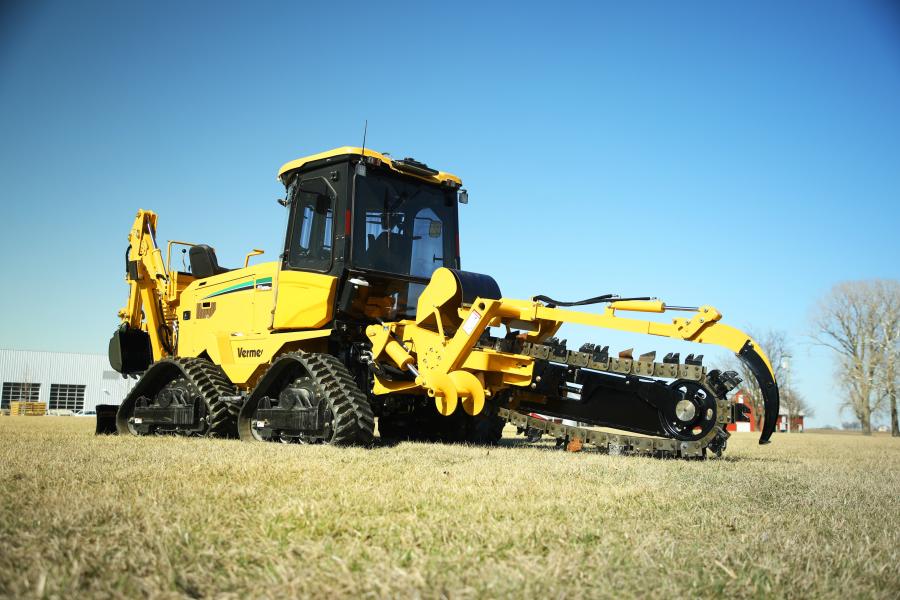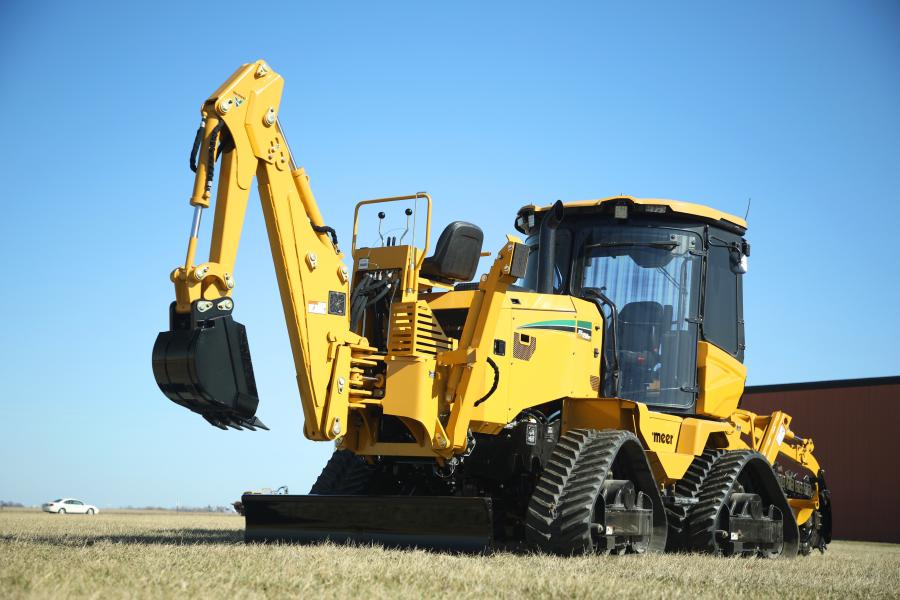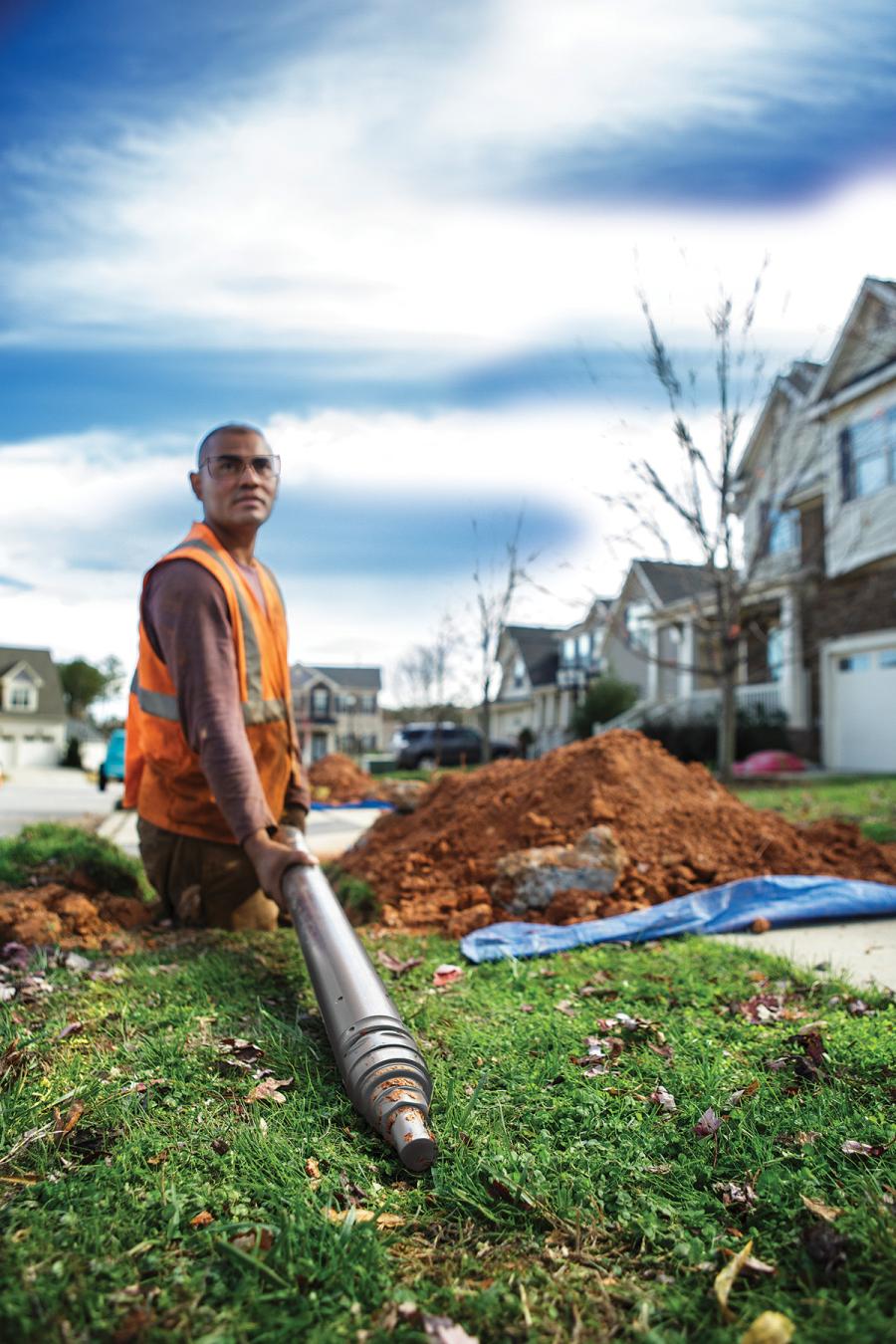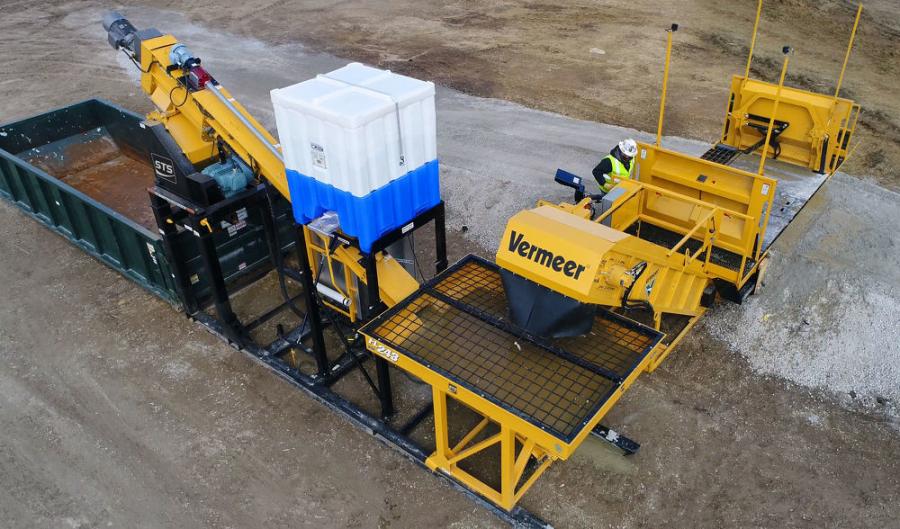The Vermeer FL243 solidification mixer and ST2000 slat tank connect to a conveyor to get the job done.
Much has been said in recent years about how the American infrastructure is in desperate need of a major overhaul. Everyone from politicians, TV pundits and ordinary people who complain about driving across inadequate streets and bridges have weighed in on the problem.
Tod Michael agrees that efforts need to be stepped up to renovate and replace our infrastructure, but he also thinks the problem needs to be properly defined.
"The theme 'America's crumbling infrastructure' tends to be more focused on highways and bridges," said Michael, product manager of Vermeer Trenchless Core Products. "However, there is still a significant amount of underground structures like sewer, water and gas utilities that are also in need of repair or replacement nationwide. A major overhaul is needed to the systems we can't see just as much as the things we can."
Although hidden just below the surface, utilities are the conduit for distributing all the power we need to maintain our busy, 21st-century lives. They demand expert installation and proper maintenance, because if things go wrong, going back in to dig and disrupt utility lines is both costly and inconvenient for consumers, as well as contractors.
Americans simply expect utilities to work and it's often shocking when they are suddenly disrupted.
Utility Work Demands Tough, Durable Equipment
Today, most public and private utility lines are located underground for reasons of both convenience and aesthetics. These would include main lines or pipes for telecommunications, electricity, water, storm drains, wastewater removal, fiber optics, cable TV, natural gas, street lights, traffic lights and oil and gas pipelines.
Therefore, the specialized equipment that helps to build and replace these critical parts of America's underground systems must be made tough and durable — for the obvious reason that their sole function is to dig and drill through dirt and rock.

Although there are many different tools used in underground utility installation, maintenance and replacement, the most prominent machines tasked with the jobs are trenchers and horizontal directional drills (HDD), the latter of which utilizes trenchless technology.
Trenchers and HDD are manufactured by Iowa-based Vermeer, while HammerHead, headquartered in Oconomwoc, Wis., has focused its energies solely on trenchless equipment and related tools.
HDDs are often undifferentiated from directional boring drills; however, the latter contrasts from HDDs in that they're capable of drilling through hundreds of feet of earth, while HDD rigs can bore through thousands of feet. So, the use of one or the other is often dependent on the size of the job.
HDD equipment is also engineered and built to utilize trenchless construction, a method in use for many years, but one that has become increasingly popular in this country only in the last 30 years.
Its obvious benefit is that it allows contractors to install or rehab existing underground utilities with little disruption to nearby traffic and businesses. HDDs bore and tunnel into the ground with minimal excavation and do so with few, if any, continuous trenches. In addition, employing trenchless equipment usually requires less restoration later.
Trenchers, on the other hand, are tractors that have proven their worth for many decades. These reliable pieces dig open cuts and utilize a process that replaced most back-breaking hand-shoveling years ago. They work well on large, open construction projects needing original utility lines or pipes.
Deciding Between Trenchers or HDDs
Long before utility installation contractors excavate the first bucket of dirt, a careful examination of the equipment, the soil and the digging processes must be performed, Michael said.
"Most underground construction projects have several factors that need to be considered when choosing between trenchless and open-cut installation methods," he said. "There are basic economics involved in the decision, like equipment, labor and restoration costs. But, there are often even more factors that contractors need to think about that impacts the decision, such as ground conditions, the diameter of the product, grade requirements, underground and above-ground obstacles, as well as location."

HammerHead Trenchless President Kevin Smith added that many of the noninvasive methods, equipment and tooling used in trenchless applications for today's underground utilities construction were first developed in Europe. There, congested rural areas, crowded infrastructure and highly valued, historic sites and architecture required an alternate approach to extensive demolition and consequent restoration.
"Yet the solutions needed to be cost-effective, permanent and safe, too" said Smith. "We formed our company to create and improve not only the technologies as they crossed over from Europe, but the techniques and product support needed for the new, noninvasive techniques. Our first piece, the HammerHead Mole, was a more reliable, easier-to-maintain pneumatic earth-piercing tool for installing utilities under roads, sidewalks and surface features without cutting through them."
Vermeer Trenchers: The Grizzly, Old Vets
Trenchers employ several different types of digging implements, depending on the width and depth of the trench needed and the hardness of the surface to be cut. Those found on wheel trenchers, for instance, are rock wheels, a toothed metal wheel. Other machines are a chain trencher, micro trencher, portable trencher and tractor mount trencher.
Vermeer manufactures 11 different tractor/trenchers, from small walk-behind units to larger utility machines. Ten larger and more powerful track trenchers are also made by Vermeer that are geared to work in rock and large diameter open-cut installation work.
Each are available with a range of attachments from standard center mount to offset with conveyor, helping consumers to meet or exceed jobsite expectations.
These trenchers slice through rock, concrete and other tough surfaces efficiently with a Vermeer rock wheel. In the process, they give operators clean, straight-sided trenches for a variety of concrete-cutting projects, including patch and joint placement on interstates, streets and highways.
A prime example of Vermeer's manufacturing is its RTX trencher models, which feature the quad-track system for work in a wider range of weather and ground conditions. This equipment is a result of Vermeer focusing its efforts on creating trencher advancements that help improve operating efficiencies.

"We want to make sure that when we develop a new machine, it is intuitive in its operation on the job," said Ed Savage, another product manager at the equipment maker. "The new Vermeer RTX1250i2 ride-on utility tractor is a recent example of this. The 'i2' represents intelligence and interchangeability. Using onboard intelligent systems, the tractor can optimize its performance based on which 'i2' attachment it is using, while also monitoring and making adjustments while trenching. At the same time, it automatically lowers the engine's idle speed when the machine controls have been inactive for a preset amount of time."
The attachments on Vermeer RTX1250i2 tractor's i2 are identified by the machine itself, which simplifies control adjustments and helps reduce the amount of time that switching out attachments typically takes, he said.
The Pella, Iowa-based manufacturer makes and sells a variety of plows that help power down through turf with minimal ground disturbance. Savage said that includes an exclusive multi-blade plow for use in underground dripper line installation, as well as versatile walk-behind plows and vibratory plows that can quickly install fiber-optic, gas and water-utility lines.
Each year, construction equipment makers develop and introduce machines that make it easier and more cost-effective for contractors to use their tractors and tools. Much of their design-work is focused on improving operator visibility and making, if one is present, a more comfortable cab.
Although Vermeer's utility-line digging equipment is already pretty-operator friendly, Savage said that many machines in the Vermeer product lineup have been incorporated with remote-control operation and, in some cases, seen the elimination of the seated operator's station or operator's cab altogether.
Boring a Pathway With HDDs
HDD is one of several techniques used in trenchless construction. The method is generally done in three principle steps. First, a small diameter pilot hole is drilled along a directional path from one surface point to another. Next, the bore created is enlarged to a diameter that will allow the installation of a pipeline. Finally, the pipeline is pulled into the enlarged hole, which creates a continuous segment of pipe underground and exposed only at the two initial end points.
Before using directional boring equipment in new construction, the contractor must carefully examine the soil conditions, and the loads applied to the surface, at the job site. HDD works well, however, in a variety of soil conditions and obstacles including road, landscape, wetland/marshes, and river crossings.
HammerHead Devoted to Trenchless
In just under 30 years, HammerHead has become an industry leader in trenchless technology after first improving on an existing pneumatic earth-piercing attachment that had long frustrated contactors with its unreliability and its problematic servicing.
Its equipment and tools are designed to be compact, allowing them to better operate in hard-to-reach locations with limited access and confined worksite conditions. Cable winches are available on track platforms to ease access in tight locations, too.

"The success of that first tool, the HammerHead Mole, propelled the company into its on-going mission to identify all tools and product lines that can be improved for our trenchless method customers," said Smith, the company's president. "When we target one, our engineering team sets out to create a product that is more reliable, easier-to-use, easily maintained, cost-effective, safer and more productive. The result is the wide variety you see today in our product offerings."
The Mole is available in more than 27 different configurations for installing new water, cable, irrigation, fiber, electrical or gas lines under yards, buildings or streets with minimal disruption and using bore diameters of 2 to 8 in. The most popular Mole is the 3-in., but many contractors keep a 4-in. model on hand, as well, for when a job calls for multiple lines.
The overall configuration of a Mole is based on tool size and choice of standard, active or Catamount head. A standard is the original, replaceable head design built for common and softer soil conditions. A replaceable head gives the tool a longer service life overall.
In more difficult ground conditions, such as cobble-filled soils or clay hardpan, the operator may opt to use the active, reciprocating head with double-strike system to increase productivity in these harder soils.
"Small teams use these tools to do a mile or more a day of residential installations," Smith said. "When our equipment is in the hands of experienced, tidy installers, residential customers usually leave for work before the installers arrive and return home without noticing the installation was completed while they were away. This happens all over the country, every day."
HammerHead's lineup of trenchless products is certainly diverse, with equipment for pipe-bursting, pipe-slitting and pipe-ramming tools, as well as HydroGuide winches with deployable in-the-pit booms and portable PortaBurst Series cable-pulling machines, and hydraulic HydroBurst-series rod-pulling units.
In addition, the company makes equipment and consumables for cured-in-place pipe (CIPP) rehabilitation of existing gravity-fed and pressure pipe in situ. That would include HammerHead inversion drums and a variety of two-part styrene-free epoxy resins, as well as felt and fiberglass reinforced liners.
The CIPP method forms a stronger, composite pipe within the existing pipe, in both horizontal and vertical applications. It works with almost any pipe material including clay, ductile, cast, PVC, ABS and concrete. CIPP pipe-renovations improve flow characteristics of the pipe and prevent future clogging, root intrusion and leakage — all without demolishing walls, floors, parking lots or driveways overlying the pipe.
To increase the capabilities of horizontal directional drilling operators, the maker's Roughneck steerable rock hammers turn HDD rotary units into highly-productive rock drilling machines at rates up to 150 ft. per hour.
"Using our Same Path technologies, utility companies, or their contractors, can also replace an underground drain pipe, water line or gas line by using the pipe-slitting method — tooling and equipment that simultaneously slits and opens the existing line while drawing a new line in its place," Smith said. "This, too, is commonly used each day, especially in crowded urban areas, most often without any disruption to pedestrians, traffic or commerce."
The pipe-slitting method makes it possible to replace gas lines and conduit with new lines when other methods, such as HDD, are prohibited from installing a new line due to an easement being crowded with other utility lines, water services or waste systems. The technology has proven to be safe, economical and efficient.
"We found that we needed to help customers frustrated by existing tooling that tended to either bunch up the pipe or high-center and get stuck," Smith continued. "HammerHead Same Path Gas Line Slitting Technology is designed for replacing ½-in. to 4-in. natural gas distribution pipe and may also be used to decommission inactive gas lines that will be left in the ground. The unique process follows the existing pipe path, reducing the likelihood of contact with other utilities."
Vermeer Also a Major Player in HDD
Vermeer started manufacturing HDD in 1991 and is currently on its S3 generation of drills, featuring enhanced speed, simplicity and sound reduction.

A sampling of its latest additions to the manufacturer's HDD offerings include the Vermeer D8x12 Navigator and the D40x55DR S3 Navigator.
Michael, the company's product manager of trenchless equipment, described the D8x12 as being a compact HDD machine intended for service installation work, primarily for installing gas, water, power and communication.
For excellent productivity in a broad range of ground conditions (hard, medium and soft rock to loam, dirt and clay), he described the D40x55DR S3 Navigator as a popular choice among utility contractors. This rock drill features dual-rod technology — an inner rod to provide torque to the drill bit and an outer rod that offers steering capability and rotational torque for reaming.
The combination provides powerful downhole cutting action and the flexibility to select the appropriate tooling to best match the ground conditions, which, Michael said, can allow the entire install to be completed with one machine.
Most of Vermeer's 15 models in its North American HDD product line available today have received higher performance specs than the previous series and can be equipped with Vermeer productivity tools and improved diagnostics.
Michael said Vermeer has also made major improvements for planning bores, reporting as-built information to customers and assisting a contractor's team to mark utility lines.
There has been a concentrated effort on the company's part to heavily reduce noise on its HDD machines in recent years, with the goal of creating less neighborhood disturbance and enabling easier communication among the crew.
Engineers at Vermeer are constantly working to improve machine performance and have developed common controls to make its HDDs more productive, while also straightening the operator learning curve.
"Industry-wide, new HDD machine models produced today utilize the latest engine emissions equipment," Michael said. "With the new engine emissions requirements, machines have typically gotten heavier. Because of weight and footprint increases, we have seen a trend toward smaller drill models doing the work larger rigs once completed."
CEG
Today's top stories





























